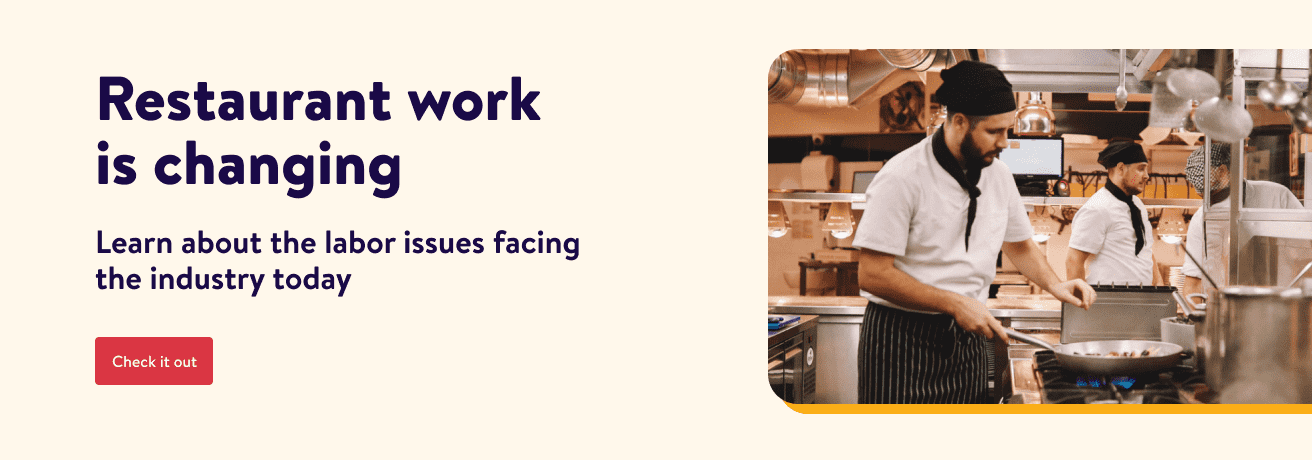Employee referrals can be a restaurant’s most powerful tool any time there’s an open role. Most established restaurants have found new team members thanks to existing employees telling their friends why they like their job and when there’s an opportunity to join the team.
You can help those referrals happen more consistently by putting an official employee referral process in place. It can turn your team into effective recruiters and trusted brand ambassadors that bring you talented hospitality pros whenever it’s time to hire. Successful referrals are a win-win for all parties involved.
Here’s everything restaurant owners need to know about creating an employee referral program that works.
Quick links
What is an employee referral?
What is an employee referral program?
What are the benefits of an employee referral program?
What are the disadvantages of employee referral programs?
How to create an employee referral program
What is an employee referral?
In the simplest terms, an employee referral is when one of your current employees tells a friend about an opportunity to work at your restaurant and connects you or a hiring manager with the potential new hire. People do this organically even when there’s no program in place. Referrals can be as easy as a team member sending you a LinkedIn page or phone number.
What is an employee referral program?
An employee referral program takes this simple, casual interaction and creates a system around it. A program lays out the proper steps employees should take to connect candidates with job opportunities.
Another component of an employee referral program is bonuses. Existing employees who help you fill a role get some kind of reward for their effort. These bonuses motivate employees to recruit other talented restaurant professionals in their network.
What are the benefits of an employee referral program?
Candidates are pre-screened
Though it’s hardly an official background check or complete reference check, referred candidates are effectively pre-screened.
Your team members really understand the work, the guests, and most importantly the company culture. They also know their friends. This means referrals tend to be especially well-qualified candidates because they will likely be good matches for your company culture. There’s less mystery for the new hire about what working at your restaurant is really like. They get it.
It’s faster
It can take a long time to fill an empty role at a restaurant. Jobs posted on job boards typically take 39 names to fill, and those posted on career sites take almost two months—55 days. Employee referrals on the other hand take only 29 days on average to become new employees. That’s almost a month faster. That’s a month less you have to spend short staffed.
Candidates are more likely to accept
You may offer a candidate a job only for them to decide to stay at their current job or choose a competing offer from another restaurant. Things can come up during the interview process that spook a candidate or make them think it wouldn’t be a good fit.
Referred applicants are more likely to accept the offer. Because they have a friend who already works there, a referred candidate comes to the process with a deeper understanding of the restaurant, the work, and the people who already work there.
You get a better culture fit
Every restaurant has its own company culture, and not every person will feel at home in every culture. Even a very competent hospitality professional may not work out if the match isn’t good or the vibes just feel off.
When a current employee makes a match between a role you have open and someone they know, it’s much more likely to be a good culture fit. That employee knows both your company culture and their friend’s personality. If the current employee thinks it’s a good match, they’re probably right.
Referred employees stay longer
Research shows that employees who find opportunities through referrals stay in those jobs longer than people who are hired via other avenues.
In the restaurant industry, where the turnover rate hovers around 75%, retaining new employees over a longer period of time is especially important. Anything you can do to improve retention rates is beneficial.
You’ll save money
Setting up a referral program is a bargain compared to hiring recruiters and hiring managers. The cost of constant posting to job sites can also be saved. Depending on what kind of bonuses you set for employees who bring new hires into the fold, it can be extremely low-cost or even free. And because referrals tend to stay in their jobs longer, you save money on job training and other onboarding costs.
What are the disadvantages of employee referral programs?
There are more pros than cons when it comes to creating an employee referral program, but that doesn’t mean there are no disadvantages to consider. There are a few distinct disadvantages, and they are very important to take into consideration.
Lack of diversity
Most restaurants have set a goal of increasing diversity and inclusion in recent years. An often overlooked drawback of an employee referral program is that it can put a damper on these efforts.
Team members don’t intend to limit diversity when they recommend someone for a job, but when they refer friends and people from their network, they tend to put forward people that look and think like them. They frequently come from the same racial, socioeconomic, and educational backgrounds.
Staying aware of this tendency can help you benefit from an employee referral program without stopping your diversity efforts in their tracks. One effective way to balance the referral program is to reach out to local schools and programs that engage a diverse population across your area.
Lack of transparency
Another possible drawback is that there can be a lack of transparency around opportunities and hiring practices. Make sure you don’t limit recruitment efforts to referrals. Post open job openings on your website and social media channels. And make sure to communicate all opportunities to your whole team. Giving people opportunities for career growth is a key part of retaining talent.
How to create an employee referral program
Once you’ve decided to have an employee referral program, you need to take steps to set it up in a way that works for you. Here are some things to consider:
Decide if it will be for specific job openings or rolling
How frequently you accept referrals will depend on your hiring goals. These days, some restaurants are always hiring and might welcome referrals any time. This rolling system means you’ll have a pile of resumes ready when you need them. The downside is that you’ll need to handle the administrative task of taking and keeping track of these referrals at all times. You are also likely to find yourself reaching out to candidates who were once interested but have since found another job.
The other option is to accept referrals only when there’s an open position. In this situation, you communicate the opportunity to the whole staff as it arises and take referrals until the role is filled.
Craft great job descriptions
Some referral programs operate like whisper-down-the-lane, with owners or managers telling some team members what job needs to be filled. Current employees then describe the job to interested people in their network. This can result in candidates who don’t accurately understand the job.
Prevent misunderstandings and miscommunications with crystal clear job descriptions. When the role and all its responsibilities are spelled out in writing, you’re more likely to surface the best candidates for the job.
Decide on bonuses
The heart of an employee referral program is bonuses. Employees who bring in great people who stick around are often rewarded. Sometimes this reward is cash. The amount of a cash bonus can range from $100 to $10,000. The amounts are tied to the level of the position and the time spent in the role. Bonuses are only awarded for a successful hire.
If cash bonuses for referrals are not in the budget, don’t despair. Other perks employees prize include getting shift preferences for a set time, extra time off, or a gift card for your restaurant or restaurant group.
Establish a formal process for referrals
It’s important that you have a process for referrals, but remember to make the process easy for employees and candidates alike.
Simply asking employees to send you a resume can be enough of a system for some restaurants. Be clear about how you’d prefer to get in touch. Either ask the employee to have the referral call or email you, or tell the employee you’ll reach out to the referral.
Some restaurants create an online form to collect information, and some even use employee referral software to manage the process.
Communicate the program to employees
Once your referral program is all set up and in place, don’t forget to communicate it to your whole team. Send an email, put a poster in the breakroom when it launches, and remind the team periodically that referrals are welcome.
With a well-oiled employee referral program in place, you can jumpstart the hiring process any time you have a job to fill.





